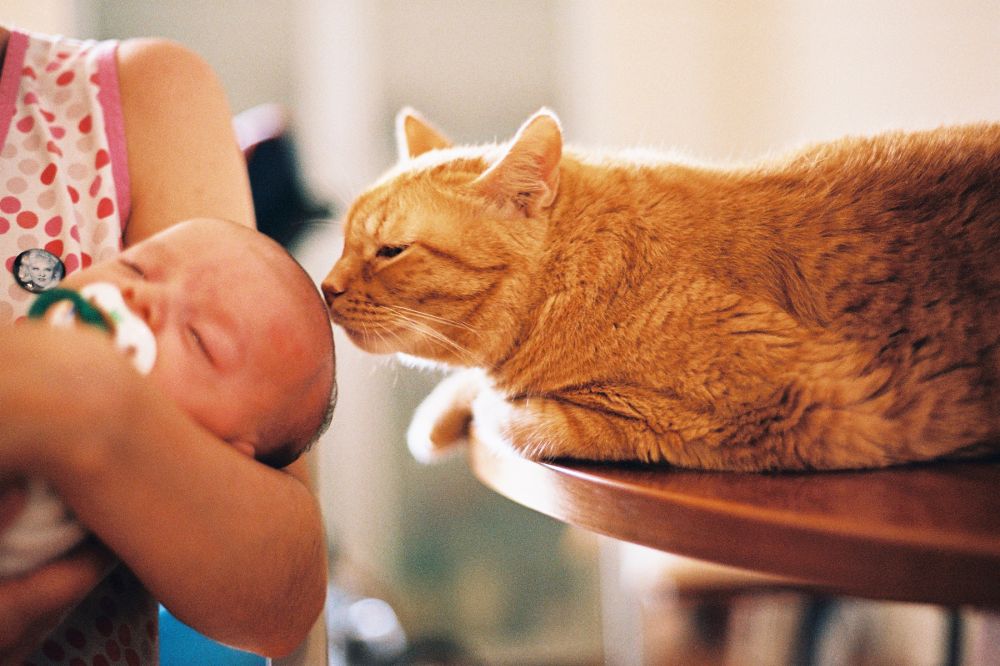Sure, you’ve heard it before but it definitely bears repeating: A baby changes everything.
If you’re a cat or dog person who is getting ready to welcome one soon, you have a lot of work to do before that little bundle of joy moves in — and we’re not just talking about clearing out the baby room of dog toys.
Dogs and cats need to be prepped before a baby joins the family (royal or not), because just as your life will change on day one, so will theirs.
“Even if your pet has been great around children in the past, bringing a new baby into your home presents a change in their usual way of life that could present some new challenges,” says Dr. Ari Zabell, a veterinarian with Banfield Pet Hospital. “Because of this, it’s important to prepare and take proper precautions with your pet before the baby arrives.”
From acclimating your pet to different sounds (screaming! cooing! fussing!) to creating a “safe zone” where your pet can escape the hubbub that comes with having a tiny human around, there are a lot of important first steps to take when a new addition is on the way. Read on for 8 expert tips for a successful transition.
1. Make necessary household changes long before baby arrives.
Think about how your daily flow will change when there’s a baby in tow — does the dog or cat need a new place to sleep? Will there be less horsing around with toys in the house? Do times for scheduled walks need to change? These are all things that should be figured out early on — you’ve got nine months, use them wisely.
“This includes anticipating and implementing any schedule and household changes prior to the baby’s arrival, for example installing baby gates, limiting access to certain areas of the home and furniture, and creating a ‘safe zone’ for your pet, to help make the transition easier,” says Zabell. “If your dog or cat usually sleeps in your bed, but you will not be allowing this after the arrival of the baby, make sure the transition to your pet’s new sleeping spot occurs well before the baby [comes]. Same goes for any other changes in routine for your pet, for example if the litter box will have a new home once the baby comes.”
2. Create a “safe zone” for your dog or cat.
There should be a place in your house where your pet can go to escape it all, because babies can be stressful, especially to a pet who may not understand how something so small can be so loud (humans may be able to relate).
“Create a safe zone for your pet away from the baby, and allow your pet unfettered access to this area,” Zabell suggests. “This could be a room or kennel with bedding, toys, water and/or a litter box.”
For dogs, a kennel can be the ideal safe space, says Zabell – it’s not a place to send them when they are bad but rather a place they can go to get away from the stresses of new sights and smells, including those of young children. “If you don’t already have a kennel for your dog to escape to, consider getting one sooner rather than later, so they can acclimate to it in advance of the baby’s arrival,” he says. “Practice separation sessions in whatever safe zone you determine is most appropriate for your pet prior to the baby’s arrival, so your pet doesn’t associate the segregation with the baby.”
3. Acclimate your pet to different sounds and smells.
There will be sounds and smells that none of you (pets and humans included) have ever heard or smelled before, and it’s smart to ready the fur family for that by getting creative. “This includes exposing them to crying baby noises via recordings, and pairing the sounds with positive reinforcements (play or treats), and acclimating your pet to baby product odors, furniture and toys by having them in the home prior to the baby’s arrival,” Zabell says.
4. Consult with a professional if needed.
Use the time that you have to consult with people who know what they’re doing and expose your pet to new experiences. “If you have fears or apprehensions related to how your pet may react to or behave around a young child, don’t wait until the baby arrives,” he says. “Chat with your veterinarian, and consider consulting a professional trainer or animal behaviorist, so they can help address these concerns and tailor a preparedness plan for you and your pet well in advance.”
Having your pet spend time with children, even years before a baby comes into the picture, is definitely a good idea. It’s obviously important to take precautions when doing so. “Ideally, every pet owner would start socializing their pets with babies and children as puppies and kittens, as it can be harder to introduce new people and things into their lives when they are grown and have already developed their own habits,” Zabell explains. “If socializing with children is completely new to your pet, doing so ahead of the baby’s arrival may help ease the transition. However, if you don’t know how your pet will react to babies or children, do so with caution – perhaps in stages or with the help of a professional trainer – and ensure the child’s parents are present and on board with the idea.”

5. Exercise caution when introducing your pet to a newborn.
The process of introducing a pet to an infant should be slow and supervised. “Once you bring your new baby home, introduce each pet to the baby one at a time, and ensure an adult is present and ready to intervene at all times,” Zabell says. “Consider putting your dog on a leash or securing your pets in carrier or kennel for starters, so they can get comfortable being in the same room before introductions begin.”
Watch for signs of “unacceptable behavior,” says Zabell, such as jumping, barking or growling. “If undesirable behaviors occur, immediately interrupt the interaction between the pet and the baby via separation or a temporary timeout. Avoid punishing your pet, as this could lead to negative association with the baby.”
Zabell says parents should be proactive, not reactive. “If there is a situation that you anticipate your pet will not do well in – for example, diaper changing or nursing – place the pet in their ‘safe zone’ or close the door during those activities,” he says. “Consult your veterinarian and/or an animal trainer or behaviorist as appropriate.”
6. Be aware of acceptable and unacceptable behaviors.
When there’s a vulnerable baby under your roof, parents should be extra vigilant about identifying safe and unsafe behaviors of pets.
“Every parent will probably have slightly different ideas about what’s acceptable behavior around their newborn, but generally speaking, pets should be calm and submissive around and toward the baby – not hyperactive, dominant, aggressive, possessive or frightened,” Zabell explains. “Dogs and sometimes even cats can get overly excited or confused around new people, including babies, which can be a sign of anxiety and stress. Your pet might become more relaxed with time, patience, and training, but in the meantime, if your pet is acting in a way that’s unsafe for your baby, keep them separated and consider slowly and safely introducing them over time.”
Keep an eye out for aggression, which could be a sign of jealousy. “Even well-adjusted dogs may exhibit protective or guarding behaviors if they feel ‘responsible’ for protecting the baby,” he says. “If your pet exhibits any aggressive, protective or guarding toward the baby, that may indicate jealousy. Regardless of the reason behind these behaviors, they should be corrected to limit potential danger for the baby – and any other person or pet who interacts with the baby.”
When it comes to jealousy, Zabell recommends slow, supervised introductions “over days or weeks, not hours, to help your pet to understand that the baby is here to stay – and that it’s a positive, not negative, addition to the family.”
7. Carve out time for your pet.
You are a new parent and also a pet owner — your new challenge is making time for both of these things! “Make sure your pet still gets the love and attention they were accustomed to despite the attention a new baby requires, and create a plan to maintain your pet’s current exercise and enrichment requirements once the baby arrives,” he says. That could mean incorporating your dog into your neighborhood walks with the stroller or hiring a dog walker to take over when needed. “If any obedience issues like jumping arise that could be dangerous with a new baby around,” he adds, “consider addressing such issues with training.”
8. Your pet is cute, but don’t assume they are perfect.
We can’t think of any right now, but even Lassie had faults. All pets do, so don’t assume that your pet is going to ace the baby thing just because he or she is good with people. Like we said, babies change everything!
“One of the mistakes people make is forgetting to prepare their pet for baby altogether or assuming no preparation is needed,” Zabell says. “We sometimes think of our pets as the most loyal and reliable family members we have, and usually, that is exactly what they are. The challenge is, a baby can greatly alter the home dynamic. If we haven’t worked with our pets to prepare them ahead of time, issues have potential to arise.”


